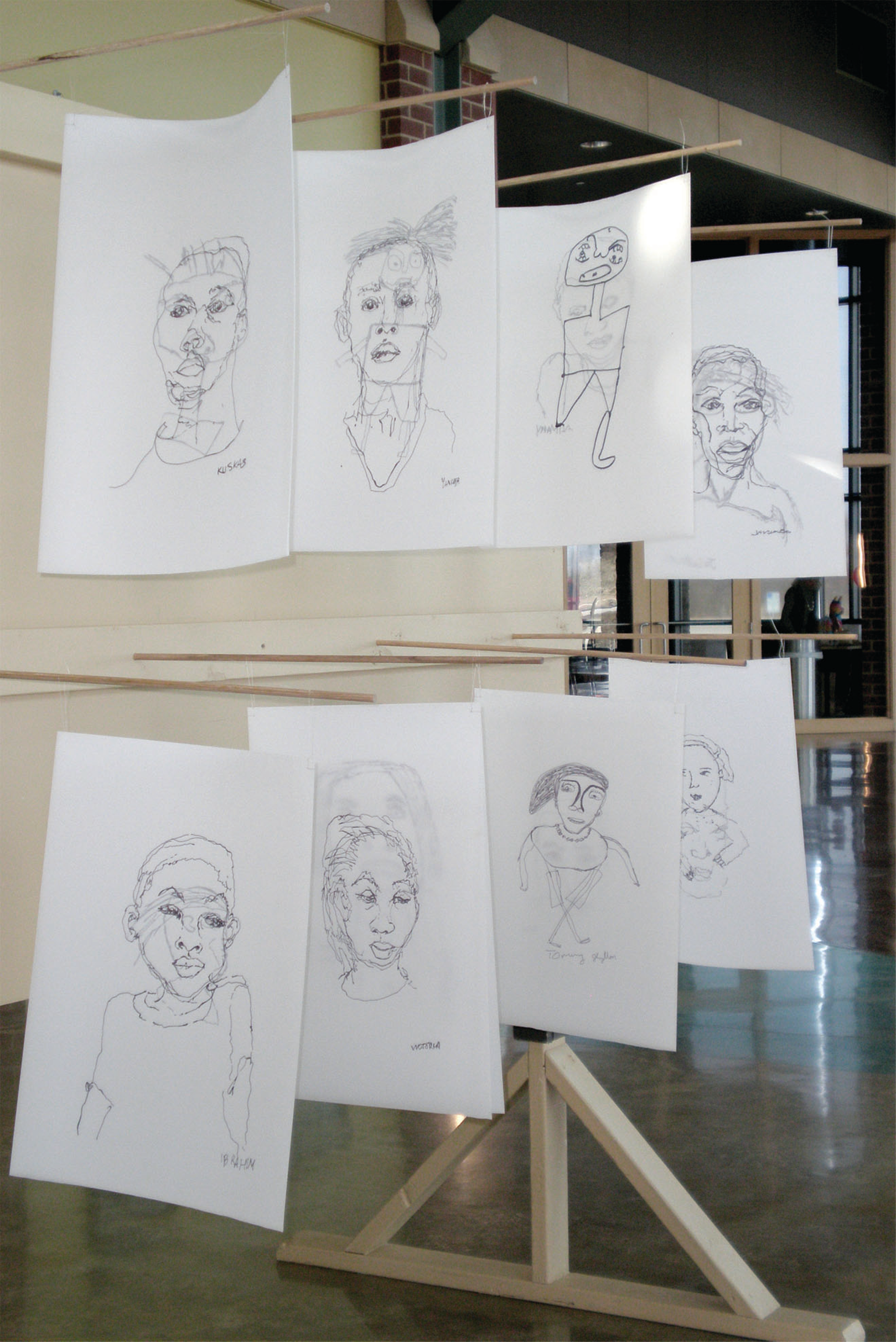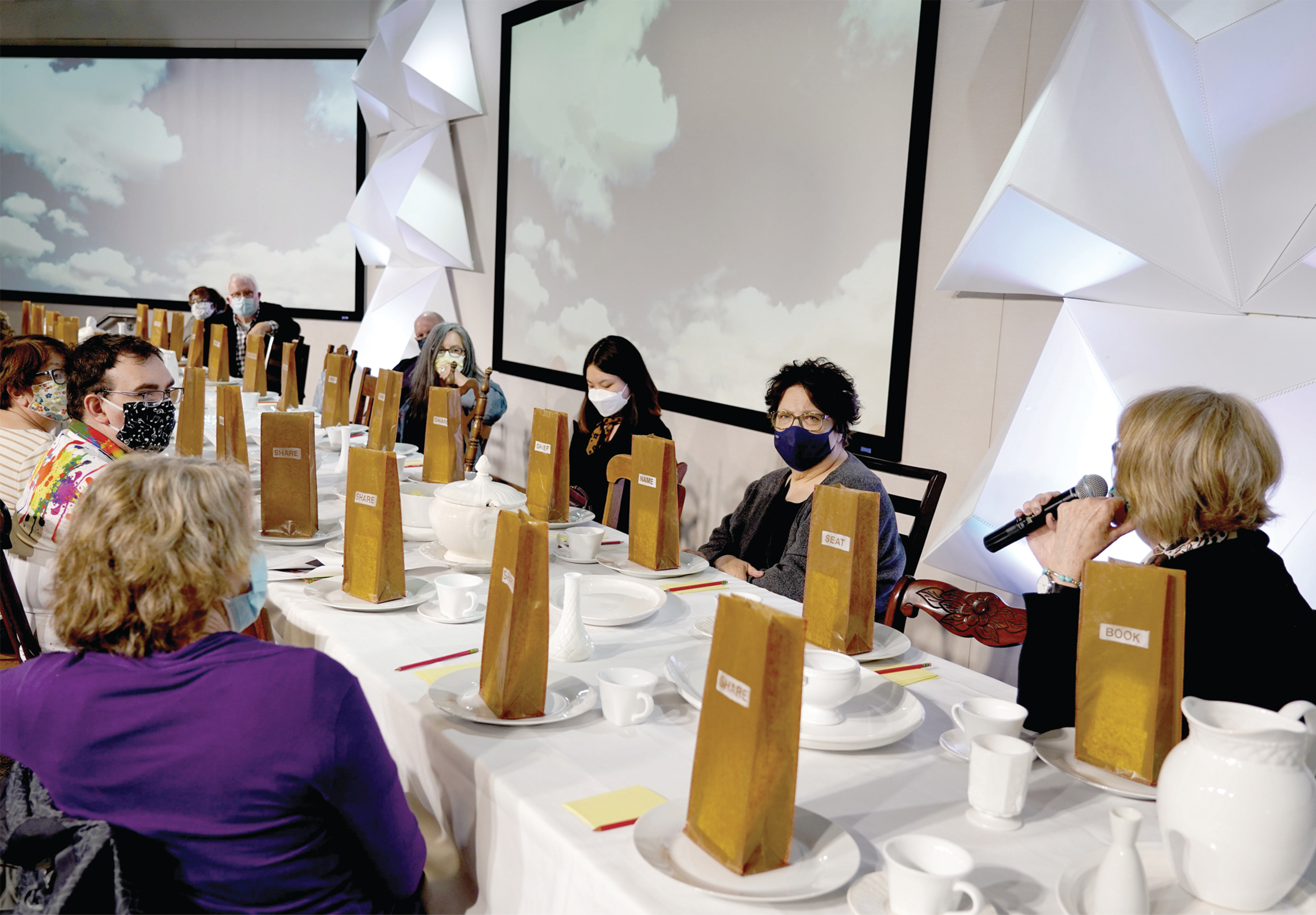Art Together, Prayer Together: Relational and Revelatory Practices of Joseph Beuys, Dietrich Bonhoeffer and Leslie Iwai
Abstract
:1. Introduction
2. Social Orientations of Conceptual Art
2.1. Joseph Beuys: Representing Christ in Social Practice
2.2. Critique and Legacy of Conceptual Art and Its Sociality
3. Bonhoeffer on Art, Prayer and Life Together
Bonhoeffer on Sociality and Prayer
Such corporate prayer has the potential to reveal the humanity of Christ among his followers.Now that Christ is with the Father, the new humanity of Christ—the body of Christ—on earth continues to pray his prayer to the end of time. This prayer belongs not to the individual member, but to the whole body of Christ. All the things of which the Psalter speaks, which individuals can never fully comprehend and call their own, live only in the whole Christ… even if a verse or a Psalm is not my own prayer, it is nevertheless the prayer of another member of the community; and it is quite certainly the prayer of the truly human Jesus Christ and his body on earth.
4. Leslie Iwai: Praying and Making Art Together
4.1. Interfacings
4.2. Share Table
5. Conclusions
Funding
Institutional Review Board Statement
Informed Consent Statement
Data Availability Statement
Conflicts of Interest
| 1 | Lippard reflects “… it has often been pointed out to me that dematerialization is an inaccurate term, that a piece of paper or a photograph is as much an object, or as ‘material,’ as a ton of lead. Granted. But for lack of a better term I have continued to refer to a process of dematerialization, or a deemphasis on material aspects (uniqueness, permanence, decorative attractiveness).” (Lippard 1973, p. 5). |
| 2 | For example, reflecting on his Honey Pump, (1977). Beuys noted that the people and their participation were essential to the work, and that it would not have existed without them (Beuys and Harlan 2005, p. xi). “The sculpture Honey Pump … arranged the space in which visitors assembled to take part in thirteen different workshops addressing such issues as the media, human rights, energy, and unemployment. Speakers from different disciplines came from all over the world. The honey continually flowing around them in huge arteries (the engines were located in an adjacent stairwell) symbolized the communal creativity that could re-energize democracy.” (Temkin et al. 1993, p. 21). |
| 3 | Volker Harlan cites the 514 events of this sort which are recorded in the Beuyskompass by M. Angerbauer-Rau, and an additional 100 days of conversation at Documenta 5 and 6 (Beuys and Harlan 2005, p. 1). See also Joesph Beuys and Dirk Schwarze’s transcription from the live installation at Documenta 5, “Report of a Day’s Proceedings at the Bureau for Direct Democracy,” (Bishop 2006, pp. 118–22). |
| 4 | See also Bonhoeffer’s ethical writings, “Christ, Reality and Good” (Bonhoeffer 2005, pp. 47–75). |
| 5 | Bonhoeffer proposes that our relationship to God is to participate in the being of Jesus, “a new life in ‘being there for others.’” What naturally follows is his proposal that “[t]he church is church only when it is there for others…The church must participate in the worldly tasks of life in the community—not dominating but helping and serving.” (Bonhoeffer 2010, pp. 504–5). |
| 6 | Beuys also had hesitations toward institutional Christianity (Mennekes 2017, pp. 76, 80). |
| 7 | “[E]ach person is an artist who demands much more from humanity than what artists are able to attain if they paint wonderful pictures… What is crucial, shall we say, is relating to the concept ‘artist’ to every person and simply to his own work.” (Mennekes 2017, p. 62). |
| 8 | Cf. John de Gruchy (2001) interprets Bonhoeffer’s “aesthetic existence,” considering the integration of ethics and aesthetics within his life and theology. This discussion takes shape within the broader context of the transformative potential of the arts, gesturing toward reconciliation between God and creation. |
| 9 | Stephen Plant reflects on the ecclesial focus of Life Together from its preface: “It is not indeed, in a basic sense, a book about theological education at all: it is a book about the mission of God’s Church. Finkenwalde is presented not as an experiment in new patterns of formation for ordained ministry, but an experiment in new ways of being Church.” (Plant 2015, p. 184). |
| 10 | As Bonhoeffer reflects in a letter to Karl Barth regarding Finkenwalde, “It is certain, however, that theological works as well as genuine pastoral community emerge only from within a life defined by morning and evening reflection on the word and by fixed times of prayer, and this is probably the result of what you yourself articulated so clearly with regard to Anselm of Canterbury. The reproach that it is somehow legal does not really concern me. What is legalistic if a Christian should learn what it means to pray and spend a good portion of his time learning to do so?” (Bonhoeffer 2013). |
| 11 | For Bonhoeffer, a unified day is ordered and rooted in prayer (Bonhoeffer 1996, pp. 75–76), and one is reminded of a monastic and particularly Benedictine integration of ora et labora. Prior to starting the seminary at Finkenwalde, Bonhoeffer had sought out monasteries and alternate seminaries, including an Anglican monastery implementing a version of the Benedictine Rule. Life there was a combination of prayer and work, praying daily through Psalm 119 and serving the poor. In addition to solemn and simple communal life, recreation enriched monastic life, this included tennis, soccer, cricket, rugby, and even ping pong (Marsh 2014, pp. 217–18). Bonhoeffer adopts a similar posture at Finkenwalde, bringing together work and prayer, spiritual formation and recreation, with the arts negotiating both of these latter practices. |
| 12 | In a similar manner, Bonhoeffer describes time alone with God as “waiting for God’s Word and coming from God’s Word with a blessing” (Bonhoeffer 1996, p. 85). |
References
- Aaker, Anne. 2018. Interview with Leslie Iwai. Available online: https://artlitlab.org/all-review/interview-with-leslie-iwai (accessed on 10 April 2022).
- Bethge, Eberhard. 1977. Dietrich Bonhoeffer: A Biography. Translated by Eric Mosbacher, Peter Ross, Betty Ross, Franke Clarke and William Glen-Doepel. Edited by Edwin Robertson. London: Collins. [Google Scholar]
- Beuys, Joseph, and Volker Harlan. 2005. What Is Art?: Conversation with Joseph Beuys. London: Clairview Books. [Google Scholar]
- Bishop, Claire Huchet. 2005. Installation Art: A Critical History. London: Tate. [Google Scholar]
- Bishop, Claire Huchet. 2006. Participation. London: Whitechapel. Cambridge: The MIT Press. [Google Scholar]
- Bonhoeffer, Dietrich. 1996. Life Together and Prayerbook of the Bible. Edited by Geffrey B. Kelly. Translated by Daniel W. Bloesch, and James H. Burtness. Dietrich Bonhoeffer Works. Minneapolis: Fortress Press, vol. 5. [Google Scholar]
- Bonhoeffer, Dietrich. 2005. Ethics. Edited by Clifford J. Green. Translated by Reinhard Krauss, Douglas W. Stott, and Charles C. West. Dietrich Bonhoeffer Works. Minneapolis: Fortress Press, vol. 6. [Google Scholar]
- Bonhoeffer, Dietrich. 2013. Theological Education at Finkenwalde, 1935–1937. Edited by H. Gaylon Barker and Mark Brocker. Translated by Douglas W. Stott. Dietrich Bonhoeffer Works. Minneapolis: Fortress Press, vol. 14, p. 254. [Google Scholar]
- Bonhoeffer, Dietrich. 2010. Letters and Papers from Prison. Edited by John W. de Gruchy. Translated by Isabel Best, Lisa E. Dahill, Reinhard Krauss, and Nancy Lukens. Dietrich Bonhoeffer Works. Minneapolis: Fortress Press, vol. 8. [Google Scholar]
- Craven, David. 2003. Conceptual Art. Grove Art Online. Available online: https://doi.org/10.1093/gao/9781884446054.article.T018962 (accessed on 20 June 2022).
- de Gruchy, John W. 2001. Restoring Broken Themes of Praise. In Christianity, Art and Transformation: Theological Aesthetics in the Struggle for Justice. Cambridge: Cambridge University Press, pp. 136–68. [Google Scholar]
- Gill, Theodor A. 1975. Bonhoeffer as Aesthete. Paper presented at American Academy of Religion Conference, Chicago, IL, USA, November. [Google Scholar]
- Green, Clifford J. 1999. Bonhoeffer: A Theology of Sociality, rev. ed. Grand Rapids: W.B. Eerdmans Pub. [Google Scholar]
- Herbert, George. 2004. Herbert: Poems. Toronto: Penguin Random House Canada Ltd. [Google Scholar]
- Iwai, Leslie. 2017. On Installation & Sabbath. CIVA SEEN Journal XVIII: 42–47. Available online: https://www.leslieiwai.com/journal/2018/1/18/civa-journal-essay (accessed on 1 April 2022).
- Iwai, Leslie. 2018. The Awkwardness of Art and Life: An Interview with Leslie Iwai. InterVarsity. Available online: https://thewell.intervarsity.org/awkwardness-art-and-life-interview-leslie-iwai (accessed on 1 April 2022).
- Iwai, Leslie. 2019. Life After Thirty|Collaboration and Community: Leslie Iwai. Image 100. Available online: https://imagejournal.org/article/life-after-thirty-8/ (accessed on 10 April 2022).
- Iwai, Leslie. 2022. Interview by Meaghan Burke. Online Interview, April 23. [Google Scholar]
- Iwai, Leslie. n.d.a. Share Table Interactive IG Live. Available online: https://www.instagram.com/tv/COQ81YdAioT/?utm_source=ig_embed&utm_campaign=loading (accessed on 20 July 2022).
- Iwai, Leslie. n.d.b. Share Table. Available online: https://www.leslieiwai.com/sharetable (accessed on 10 April 2022).
- Lippard, Lucy R. 1973. Six Years: The Dematerialization of the Art Object from 1966 to 1972; a Cross-Reference Book of Information on Some Esthetic Boundaries. New York: Praeger. [Google Scholar]
- Marsh, Charles. 2014. Strange Glory: A Life of Dietrich Bonhoeffer. New York: Alfred A. Knopf. [Google Scholar]
- Marzona, Daniel, and Uta Grosenick, eds. 2005. Conceptual Art. Cologne: Taschen. [Google Scholar]
- Mennekes, Friedhelm. 2017. Joseph Beuys: Christus “Denken” = “Thinking” Christ. Stuttgart: Verlag Katholisches Bibelwerk. [Google Scholar]
- Plant, Stephen. 2015. Theological Education and Christian Formation in Conversation with Dietrich Bonhoeffer’s Life Together. Colloquium, Australian and New Zealand Association of Theological Schools 47: 180–94. [Google Scholar]
- Stimson, Blake. 1999. The Promise of Conceptual Art. In Conceptual Art: A Critical Anthology. Edited by Alexander Alberro and Blake Stimson. Cambridge: MIT Press, pp. xxxvii–lii. [Google Scholar]
- Temkin, Ann, Joseph Beuys, Bernice Rose, and Dieter Koepplin. 1993. Thinking Is Form: The Drawings of Joseph Beuys. Philadelphia: Philadelphia Museum of Art. [Google Scholar]
- The Miller Art Museum. 2022. Winter’s Spring: An Ältere Garten By Leslie Iwai. Available online: https://millerartmuseum.org/winter-s-spring-an-aeltere-garten-by-leslie-iwai-2 (accessed on 28 November 2022).
- The Upwards Podcast. 2021. Art as a Journey|Leslie Iwai. Available online: https://anchor.fm/upwords/episodes/Art-as-a-Journey--Leslie-Iwai-e102t7m (accessed on 20 July 2022).
- Upper House. 2021a. UNVEILED Artist Insights-Leslie Iwai. Available online: https://www.upperhouse.org/media/unveiled-artist-insights-leslie-iwai/ (accessed on 1 May 2022).
- Upper House. 2021b. UNVEILED Prayers of the People (Now through May 6). Available online: https://www.upperhouse.org/event/unveiled-prayers-of-the-people/ (accessed on 1 May 2022).
- Worley, Taylor. 2020. Life after Death: Joseph Beuys and Re-enchantment. In Memento Mori in Contemporary Art: Theologies of Lament and Hope. Abingdon and Oxon: Routledge, pp. 75–126. [Google Scholar]



Disclaimer/Publisher’s Note: The statements, opinions and data contained in all publications are solely those of the individual author(s) and contributor(s) and not of MDPI and/or the editor(s). MDPI and/or the editor(s) disclaim responsibility for any injury to people or property resulting from any ideas, methods, instructions or products referred to in the content. |
© 2022 by the author. Licensee MDPI, Basel, Switzerland. This article is an open access article distributed under the terms and conditions of the Creative Commons Attribution (CC BY) license (https://creativecommons.org/licenses/by/4.0/).
Share and Cite
Burke, M. Art Together, Prayer Together: Relational and Revelatory Practices of Joseph Beuys, Dietrich Bonhoeffer and Leslie Iwai. Religions 2023, 14, 24. https://doi.org/10.3390/rel14010024
Burke M. Art Together, Prayer Together: Relational and Revelatory Practices of Joseph Beuys, Dietrich Bonhoeffer and Leslie Iwai. Religions. 2023; 14(1):24. https://doi.org/10.3390/rel14010024
Chicago/Turabian StyleBurke, Meaghan. 2023. "Art Together, Prayer Together: Relational and Revelatory Practices of Joseph Beuys, Dietrich Bonhoeffer and Leslie Iwai" Religions 14, no. 1: 24. https://doi.org/10.3390/rel14010024
APA StyleBurke, M. (2023). Art Together, Prayer Together: Relational and Revelatory Practices of Joseph Beuys, Dietrich Bonhoeffer and Leslie Iwai. Religions, 14(1), 24. https://doi.org/10.3390/rel14010024




